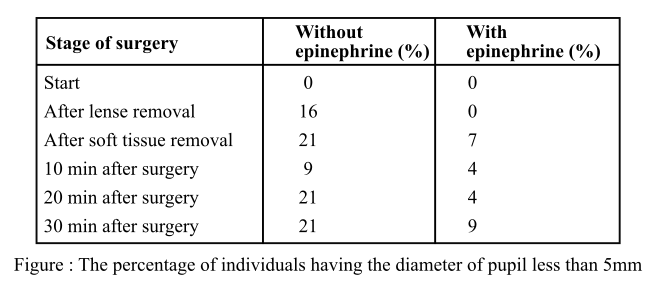
To review:
The hypothesis that have led to the results in table by the production of epinephrine.
Given:
Cataract in humans is a fatal disease that leads to loss of vision. It is caused by excessive exposure to ultraviolet light and also due to the age factor. There is cloudy appearance and non-transparency of the lens. The cataract has to be removed by the surgeon for the recovery of sight. For surgery, the surgeon makes sure that pupil is dilated properly and for a longer time. The dilation of the pupil is controlled by adrenal medulla which releases epinephrine and norepinephrine.
An experiment was conducted by the researchers to find if epinephrine can help in keeping the pupil dilated for a longer time during cataract surgeries. Epinephrine was injected into the eye of the 27 patients who came for cataract surgery but not injected in the eyes of other 43 other patients.
The following table depicts the percentage of patients whose eyes had the pupil diameter size less than five mm during the different stages of the cataract surgery.

The percentage of individuals having the diameter of pupil less than five mm
Introduction:
Pupil is a small opening in the iris which is surrounded by two types of smooth muscles. Light is perceived by the pupil and reaches the retina of the eye for image formation. Epinephrine is a fight fright and flight hormone which has the direct control over the contraction and relaxation of the pupil. The dilation of pupil by epinephrine increases its size while contraction reduces the size.
Want to see the full answer?
Check out a sample textbook solution
Chapter 40 Solutions
Life: The Science of Biology
- Give typed full explanation this anticholinergic agent is available as a transdermal patch . A. tolterodine B. oxybutynin C. both a and b D. neither a nor barrow_forwardTrue or false: At the center of the fovea, each P-type RGC’s receptive field contains just one photoreceptor. Reminder: these RGCs are color-opponent.arrow_forwardButaclamol is a potent antipsychotic that has been used clinically in the treatment of schizophrenia. How many asymmetric centers does it have?arrow_forward
- Explain why some taste receptor cells and all olfactoryreceptor cells use G protein-coupled receptors, yet onlyolfactory receptor cells produce action potentials.arrow_forwardExplain which component does the KDEL receptor bind its ligand more tightly and more weakly.arrow_forwardIn the increased white matter vulnerability to repeat mTBI for at least 2 weeks post-injury section of the results section the authors wrote “Percentage silver staining area was used to quantify the extent of white matter damage in the optic tract and corpus callosum regions of mice.” Based on this quote, what part of the neuron (axon, axon terminal, cell body or dendrite) was damaged?arrow_forward
- Aspirin and ibuprofen, over-the-counter pain killers inhibit an enzyme (prostaglandin synthase) which transform arachidonate to prostaglandin structures.arrow_forwardMany nonsalicylic, nonsteroidal anti- inflammatory drugs (NSAIDs) inhibit pain transmission by the inhibition of __________________. Histamine Serotonin Prostaglandin Bradykininarrow_forwardOzana was born with cataracts, which made her completely blind. When she was 14 years-old she underwent surgery to remove the cataracts, which allowed visual input to be transmitted to her brain for the first time. However, even though the surgery was a success, Ozana’s vision was never fully functional. A) Describe how the features of neural plasticity might help to explain why Ozana’s vision was not restored. B) Propose one factor that might have increased the chance that Ozana would develop the ability to see, and briefly explain why.arrow_forward
- Briefly explain the difference between a receptor antagonist and a receptor inverse agonist. Describe both the resulting receptor conformation as well as the signal transduction.arrow_forwardWhat might be the possible mechanism for the effect of gynema on the perception of taste? With detarrow_forwardoutline the neurochemical transmission and inhibition of pain. Then using the gate-control theory, devise a plan to minimize pain during your next visit to the dentist. Why is this important for you to know in public healtharrow_forward
 Human Physiology: From Cells to Systems (MindTap ...BiologyISBN:9781285866932Author:Lauralee SherwoodPublisher:Cengage Learning
Human Physiology: From Cells to Systems (MindTap ...BiologyISBN:9781285866932Author:Lauralee SherwoodPublisher:Cengage Learning
